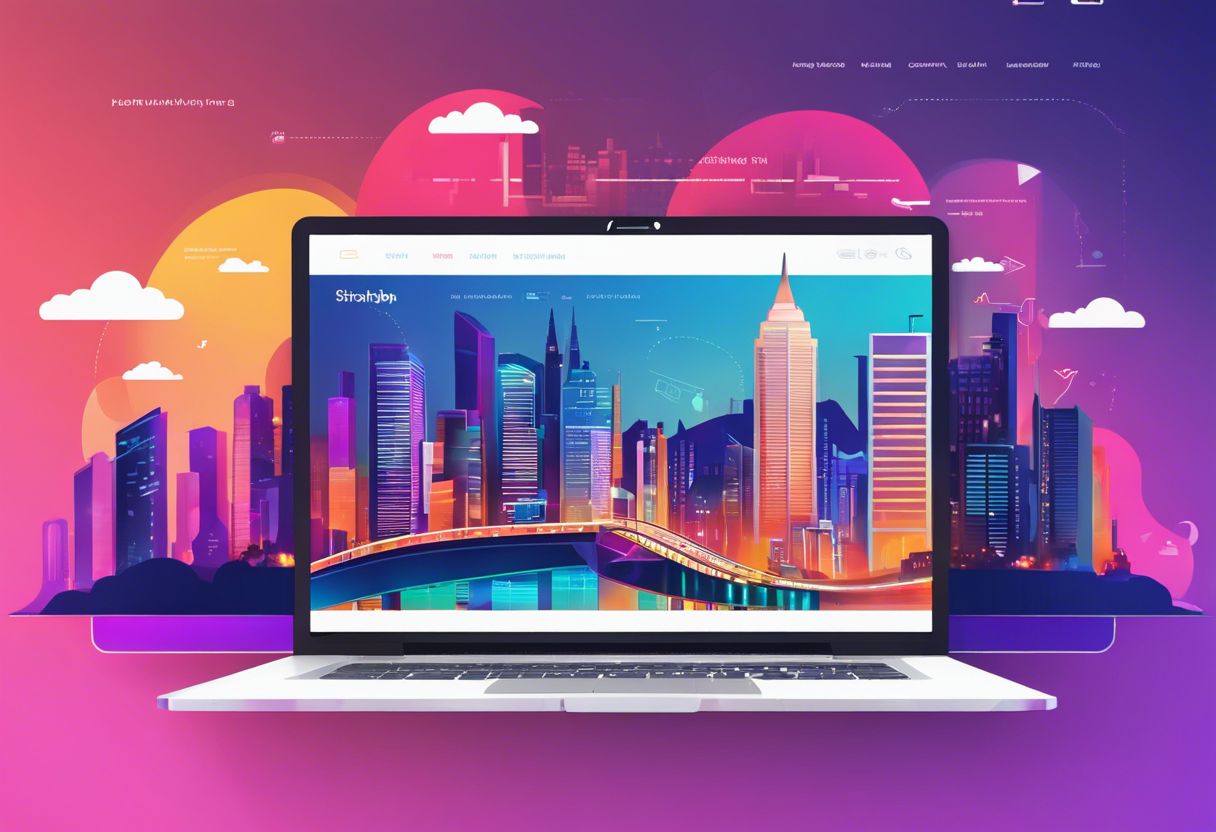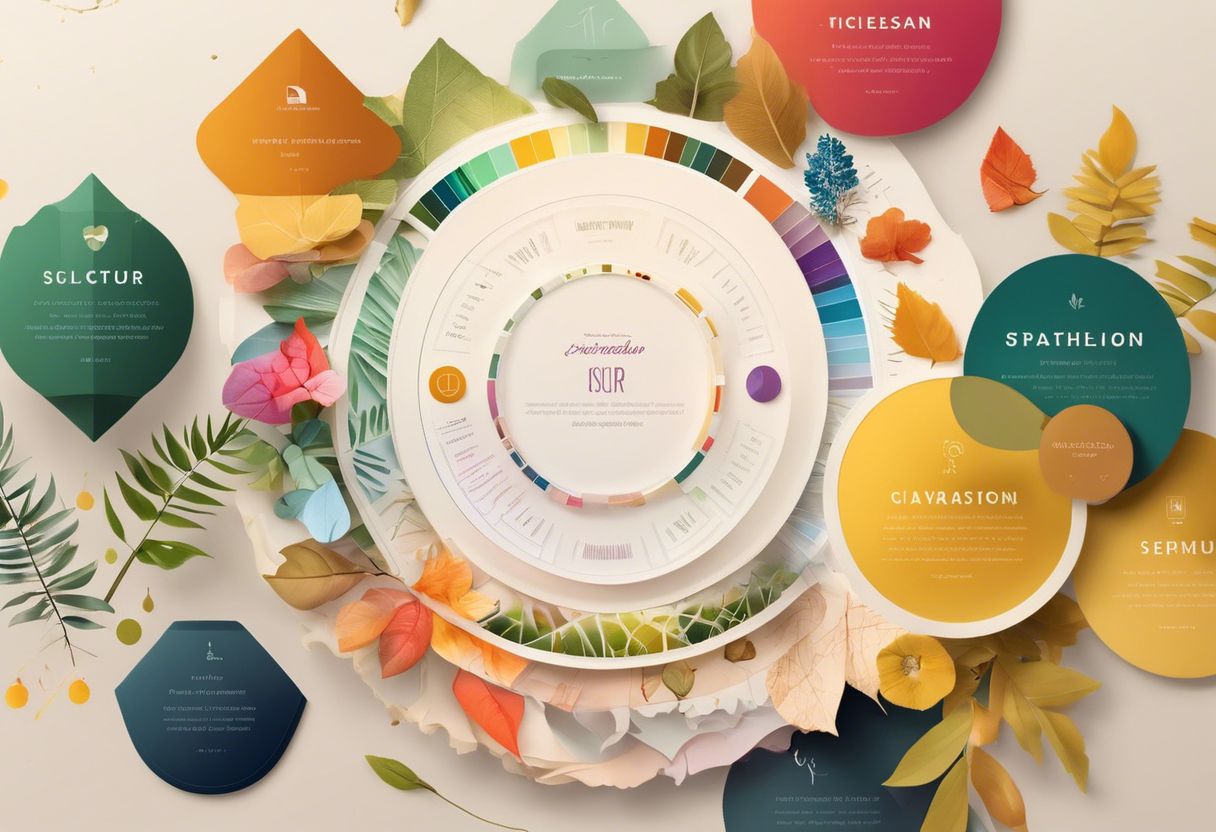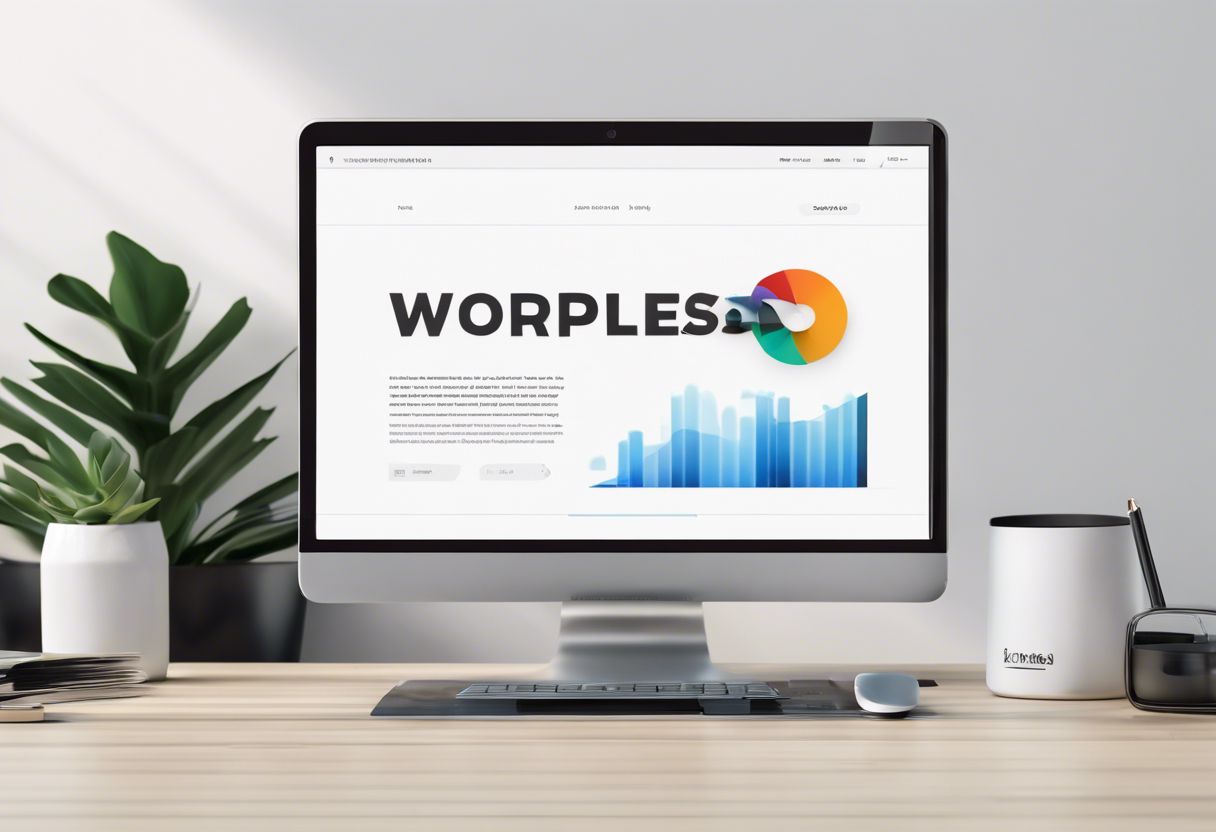Landing Page Brilliance: Best Practices For High Conversions

Hello, business owners! Ever heard of landing pages? They’re special web pages you send people to, and they’re super important for getting customers. A landing page done right can make a big difference in how many people buy your stuff or sign up for what you offer.
Imagine making a poster that tells people all about one amazing thing you sell. You’d want it to look great, sound exciting, and get folks to buy, right? Well, that’s what high-converting landing pages do on the internet.
They use smart headlines, cool pictures or videos, and just the right words to help visitors decide to click that “buy” or “sign up” button.
We’ll talk about all kinds of neat tricks like how colors can make a difference and why putting things in the right spot guides people on what to do next. We also show how talking with robots (chatbots) on your page can be a big win!
Before we go into this adventure together, remember: knowing who wants your stuff is key. Once you understand who they are and what they like using tools like Google Trends – bam! – you’ve got power.
And don’t forget testing different versions of your page because learning from real clicks helps make things even better.
Now let’s jump in and discover how crafty design choices help turn curious visitors into customers!
Understanding the Role of Landing Pages

Landing pages play a crucial role in the conversion process, serving as a powerful tool to guide potential customers towards taking specific actions. They are an integral part of digital marketing strategies and serve as the initial point of contact for many users, making it essential to craft them with precision and purpose.
Why Landing Pages are Crucial for Conversion

Landing pages are key to turning visitors into customers. Imagine someone clicking your ad; you want them landing on a page that grabs their attention and tells them exactly what they get by choosing you.
These special pages let us show off what’s great about our products or services. They’re like welcoming guides, leading potential customers through the door.
We need these pages to be focused and clear. A good landing page talks directly to the target audience, showing them the value proposition in a straightforward way. It has one goal: getting people to take action, whether signing up for a newsletter or buying something.
Think of it as a friendly but persuasive conversation where we lead with our best points first.
Every time we use chatbots, amazing images, or strong calls-to-action on our landing pages, we’re aiming for better customer engagement and more sales leads. Each part of the page works towards conversion optimization—getting people excited enough to click that button! We make sure users have an easy and helpful experience because when they do, they’re more likely to trust us and come back for more.
The Relationship Between Landing Pages and Digital Marketing

We know that landing pages play a big part in digital marketing. They’re like special pages made just to turn someone who visits into someone who acts, like buying something or signing up for emails.
Think of them as your online salespeople working 24/7.
Digital marketing uses these landing pages to catch people after they click on ads or search results. This is where you want them to do something specific without getting lost on your main website.
A good landing page will give visitors exactly what they promised in the ad and guide them towards an action, making it more likely they’ll do what you want.
Having strong landing pages means we can show off our business all over social media and search engines better. That’s how we get ahead of others and make sure people pick us over competitors, which is super important for winning online.
Next, let’s explore the different types of effective landing pages that can help boost our engagement and conversions!
Types of Effective Landing Pages

Landing pages come in various forms, each designed to engage and convert visitors in different ways. From text-only pages that focus on compelling copy to video-based showcases of products or services, understanding the unique benefits of different types of landing pages is crucial for maximizing conversions.
Text-Only Landing Pages

Text-only landing pages work great when we want to send a clear message without any distractions. We focus on strong writing that tells visitors exactly what they will get and why it’s valuable.
This kind of page is all about the words – no images, no videos, just straight facts delivered in a way that makes you stand out and stick in people’s minds.
We use these pages because sometimes simplicity wins. It’s less for people to load and can make your web page super fast. These are perfect for quick marketing campaigns where you want high conversion rates with no fuss or frill—just results! Now let’s look at how adding video can take our landing pages to the next level.
Video Landing Pages

Video landing pages are a powerful tool for engaging and converting visitors. Research shows that including video content can lead to 34% higher conversion rates, making it a critical element in your digital marketing strategy.
When using video on landing pages, it’s important to focus on high-quality production and compelling storytelling to capture the audience’s attention.
Incorporating videos into your landing pages can significantly increase user engagement and drive customer acquisition. It allows you to showcase your products or services in an immersive and impactful way, creating a memorable experience for potential customers.
Product/Service Showcase Pages
After exploring the effectiveness of video landing pages, it’s essential to understand the impact of product/service showcase pages in driving conversions. These specially crafted showcase pages play a pivotal role in marketing or advertising campaigns, aiming to attract prospects and boost sales.
Whether it’s showcasing a new product or promoting a service, these pages provide detailed information about the offering, emphasizing its unique features and benefits. The primary goal is to entice visitors to take action, such as making a purchase or signing up for a webinar.
It’s crucial to note that product/service showcase pages must align with the best practices for high-converting landing pages. This includes maintaining clear and compelling copy that resonates with potential customers and ensuring that the call-to-action is prominently displayed above the fold.
Key Elements of High-Converting Landing Pages

Crafting high-converting landing pages requires attention to key elements such as compelling headings and subheadings, engaging copy that highlights benefits, and the use of high-quality images and videos.
These elements work together to attract and retain the interest of visitors while leading them towards taking action.
Compelling Headings and Subheadings
Engaging headlines and subheadings are vital for capturing the attention of visitors on your landing page. These captivating titles and attention-grabbing headings draw people into your content, making them more likely to stay and take action.
A smart, succinct headline is the first thing readers see, so it must describe a problem, offer a solution, and highlight your product’s unique value. Compelling taglines and persuasive call-to-action phrases also play a crucial role in driving conversions on your landing page by guiding visitors towards taking the desired action.
The headline often determines whether someone will continue reading or leave, making it one of the most critical components of a high-converting landing page. Therefore, crafting powerful headlines that speak directly to your audience’s needs can significantly impact conversion rates.
Engaging Copy that Highlights Benefits
Crafting compelling copy that highlights the benefits of your product or service is crucial for a high-converting landing page. Our persuasive writing should focus on showcasing how our offering can make a difference in our customers’ lives.
Using enticing language, we must emphasize the unique selling points and advantages that set us apart from the competition. It’s essential to communicate the specific benefits and value that our audience will gain by engaging with our product or service, rather than just listing its features.
Incorporating customer endorsements can also add credibility to our messaging, making it more persuasive.
When creating engaging copy for landing pages, we need to use captivating content that speaks directly to potential customers’ needs and desires. By using compelling language tailored towards highlighting the benefits, we can motivate readers to take action and explore what we have to offer.
High-Quality Images and Videos
When creating high-converting landing pages, captivating images and engaging videos play a vital role in capturing the attention of potential customers. Compelling visuals have the power to convey your message at a glance, drawing visitors into your content.
Stunning photography, persuasive graphics, and eyecatching multimedia all contribute to effective visual communication that can make a lasting impact on your audience. By incorporating high-quality images and videos that align with your brand and messaging, you can enhance the overall user experience and increase the likelihood of conversion.
Visual storytelling is an essential aspect of modern marketing strategies, as it allows businesses to connect with their target audience on a deeper level. Effective use of visuals can evoke emotion and drive engagement, effectively conveying the value proposition of your product or service.
Enhancing User Interaction on Landing Pages with Chatbots

Interactive landing pages are vital for engaging visitors and enhancing user experience. By integrating chatbots, businesses can optimize their landing pages for high conversion rates.
Chatbots provide a conversational interface that answers visitor queries, guides navigation, and attracts user attention. This innovative tool fosters meaningful interaction on the page, ultimately boosting user engagement and driving conversion rate optimization.
Incorporating chatbots allows businesses to create a more personalized and responsive experience for visitors, leading to higher satisfaction levels and increased conversions.
Moving forward to “6. The Importance of Market Research,” let’s explore how understanding market trends empowers businesses to tailor their landing pages effectively.
The Importance of Market Research

Understanding your target audience is crucial for crafting a high-converting landing page. By utilizing tools like Google Trends, you can gain valuable insight into the interests and behaviors of your potential customers, allowing you to tailor your landing page content accordingly.
Utilizing Google Trends for Insight
Google Trends is a powerful tool that allows you to analyze search patterns and identify current trends. By utilizing this tool, we can gain valuable insights into popular topics and keywords related to our business.
This can help in optimizing our website content, identifying relevant keywords, and understanding what our audience is searching for. Moreover, Google Trends enables us to compare the popularity of different keywords over time, which can guide our SEO strategy and content marketing efforts.
Additionally, Google Trends provides data on trending search queries that can be used for creating targeted content. Understanding these search trends helps us tailor our content to meet the current interests of our audience.
Understanding Your Target Audience
By analyzing the insights gained from utilizing Google Trends, we can gain a deeper understanding of our target audience. Consumer behavior, customer preferences, and buyer personas are essential aspects to consider when crafting high-converting landing pages.
Market research provides valuable data on demographics, psychographics, and market segmentation which help in shaping effective strategies. Understanding the needs and wants of our target market allows us to tailor landing page elements such as compelling headlines, engaging copy, and visuals that resonate with their preferences.
Customer insights obtained through competitive analysis empower us to create landing pages that align with what our audience is seeking. By identifying their pain points and desires, we can speak directly to the reader in a persuasive manner while showcasing offers and incentives that appeal to them specifically.
Designing for Conversion

When it comes to designing landing pages for high conversions, it’s crucial to follow design best practices that prioritize user experience and engagement. By utilizing the right tools and implementing a clean, visually appealing layout, you can create landing pages that effectively guide users towards taking action.
Landing Page Design Best Practices
When designing a landing page, we need to focus on user-friendly navigation and clear, compelling copy. It’s important to create a mobile-responsive design and conduct A/B testing for optimal results.
Ensuring brand consistency across the page is essential for high conversion rates. Keeping the call-to-action above the fold and using directional cues are also crucial elements that guide users towards conversion.
Additionally, matching the message on the landing page with the ads maintains credibility and boosts conversion rates.
Tools for Crafting the Perfect Landing Page
When crafting a high-converting landing page, having the right tools can make all the difference. Utilizing website builders tailored for conversion optimization is a crucial first step.
These platforms offer responsive design templates and user engagement features to capture visitors’ attention effectively. By leveraging these tools, business owners can easily create compelling call-to-action buttons, generate leads through forms, and conduct A/B testing to fine-tune their landing pages for maximum impact.
In addition to streamlined page-building capabilities, many of these tools also provide valuable insights into conversion rates and user experiences. They offer practical benefits by simplifying the process of designing for conversion and enhancing overall performance metrics.
The Psychology Behind Landing Page Elements

Understanding the impact of colors on conversion and how visual hierarchy guides user behavior can be crucial for creating a high-converting landing page. By delving into the psychological factors at play, you can craft a landing page that resonates with your audience on a deeper level and compels them to take action.
The Impact of Colors on Conversion
The psychology of color is fascinating. Different colors can make people feel different ways. For example, red can create a sense of urgency while green is associated with positivity and wealth.
This applies to your website too! The right colors on your landing page can influence how potential customers react to what you’re offering. In fact, studies show that the color scheme used on a landing page greatly affects customer response and the conversion rate of visitors.
So, choosing the right colors for your branding and website design can have a big impact on whether people take action or not.
Color psychology matters in marketing because it helps create positive associations and influences customer behavior. It’s essential to pay attention to this when designing your landing pages if you want to optimize conversion rates effectively.
How Visual Hierarchy Guides User Behavior
When designing a landing page, we strategically arrange and prioritize the elements to guide the user’s attention. This visual hierarchyensures that visitors focus on the most critical information and actions on the page.
By using techniques such as size and color, we can effectively direct users’ attention to significant elements, ultimately optimizing their experience for higher conversions.
The arrangement of design elements plays a crucial role in leading visitors’ eyes towards essential information on a landing page. Understanding the psychology behind effective landing page design allows us to make informed design decisions that positively influence user behavior and guide them towards desired actions.
Crafting a Landing Page That C. O. N

Crafting a landing page that converts requires careful consideration of key elements like compelling headlines, engaging copy, high-quality visuals, clear calls to action, and social proof.
Each aspect plays a crucial role in guiding users towards taking the desired action on your landing page. Ready to create a winning landing page that converts? Let’s dive in and explore the essential components for success.
Creating a Clear Call to Action
Crafting a compelling call to action (CTA) is paramount in driving conversions on your landing page. Utilize persuasive language and clear instructions to encourage visitors to take the desired action, whether it’s making a purchase, signing up for a newsletter, or scheduling a consultation.
Implement scarcity tactics and urgency messaging in your CTAs strategically to create a sense of FOMO (fear of missing out) and prompt immediate action from your audience. Remember that having fewer distractions on your landing page contributes to an enhanced user experience, so keep the focus on your CTA by minimizing unnecessary links that can divert attention away from the main conversion goal.
Employing effective CTAs not only guides visitors through their buying journey but also significantly impacts conversion rates. It’s essential to craft CTAs that align with your business goals while keeping the user experience at the forefront of your strategy.
By implementing persuasive calls-to-action supported by scarcity tactics and streamlined design, you’ll set the stage for increased conversions and improved user engagement.
Showcasing Offers and Incentives
Crafting a landing page that converts means showing off the attractive deals, special offers, and incentives your business provides. By displaying promotions, discounts, or savings prominently on your landing page, you’re encouraging visitors to take action.
Customers love bonuses and rewards, so make sure to highlight these to entice them further.
Including clear calls to action for these offers will guide potential customers into making a purchase or taking the desired action. Utilize persuasive language alongside appealing visuals to draw attention and encourage engagement with the incentives showcased on your landing page.
Maintaining a Narrow Focus
To ensure our landing pages are effective in captivating the attention of our target audience, we understand the significance of maintaining a narrow focus. By concentrating on a specific product or service and its key attributes, we provide a clear direction to users, prompting them to take the desired action.
Research shows that when landing pages maintain this sharp focus, they can significantly enhance conversion rates by reducing distractions and guiding users towards making a decision.
This focused approach not only simplifies user experience but also reinforces the value proposition, ultimately leading to higher engagement and improved lead generation. Therefore, adhering to maintaining a narrow focus is fundamental in crafting high-converting landing pages.
The practice of “Maintaining a Narrow Focus” aligns with our goal-oriented language by emphasizing clarity and effectiveness to achieve specific goals related to conversion rate optimization and customer acquisition.
Highlighting Very Important Attributes (VIA)
Crafting a landing page that converts effectively requires Highlighting Very Important Attributes (VIA) to capture and maintain the attention of potential leads. VIA involves presenting the most essential information, benefits, or unique selling points prominently on your landing page.
This ensures that visitors can quickly grasp why they should engage with your offer. By showcasing very important attributes through compelling headlines, engaging copy, high-quality visuals, and persuasive CTAs, you can significantly impact conversion rates.
Utilizing VIA is a strategic approach backed by data-driven decisions to drive visitor actions such as signing up or making purchases. When we focus on highlighting the most critical aspects of our offerings in a clear and concise manner, we enhance user experience and increase the likelihood of conversions.
Constructing an Effective Headline
Crafting a captivating headline is a crucial element of a high-converting landing page. The headline serves as the first impression and should clearly communicate the value proposition to visitors, drawing them in and persuading them to explore further.
It’s essential to create a compelling headline that entices the audience by highlighting the benefits or solutions offered. By crafting an engaging headline, business owners can significantly improve their conversion rates, potentially seeing an increase of up to 67.8%.
Therefore, it’s vital for us as business owners to invest time and effort into creating persuasive headlines that resonate with our target audience and drive action.
When we are constructing an effective headline for our landing page, we need to remember that it plays a pivotal role in capturing the attention of potential customers. Hence, utilizing keywords like “captivating,” “compelling,” and “enticing” can guide us in developing headlines that attract our audience while reinforcing the value we offer.
Additionally, incorporating numbers and specifics within the headline can bring clarity and directness, prompting readers to engage further with what we have on offer.
Designing a Resolution-Savvy Layout
Crafting a layout that adapts seamlessly to various screen resolutions is essential for engaging users and boosting conversions. A resolution-savvy design ensures that your landing page looks impeccable and functions flawlessly, regardless of the device used by your audience.
By prioritizing responsive design, user engagement substantially increases as visitors enjoy a consistent and visually appealing experience across different devices. This practice aligns with our goal to optimize conversion rates by providing a user-friendly interface that captivates potential customers from their first interaction with our landing page.
The relevance of visual hierarchy in web layout cannot be overstated. The strategic placement of elements within the layout influences how users perceive information and navigate through the content.
Keeping Visuals Tidy and Organized
When designing a landing page, we understand the importance of keeping visuals tidy and organized. Neat and structured visuals convey professionalism and credibility to your audience.
Ensuring that your images, videos, and graphics are clean and appealing can significantly enhance user engagement and drive conversions. An organized visual layout not only makes your landing page more attractive but also helps in effectively communicating your message to potential customers.
An orderly visual design is crucial for creating an engaging user experience that guides visitors towards taking action, which ultimately leads to higher conversion rates. By maintaining a visually enticing and professional appearance on your landing page, you can establish trust with your audience and leave a lasting impression that encourages them to explore further or make a purchase decision.
Crafting an aesthetically pleasing visual environment contributes to the overall success of your landing page by capturing attention, building interest, and driving meaningful interactions with potential customers.
Understanding how tidiness impacts the effectiveness of visuals on a landing page is essential for achieving high conversion rates while providing users with a seamless experience.
Including Social Proof and Testimonials
We know that our landing page needs to convince potential customers. One powerful way to do this is by including social proof and testimonials. These endorsements, customer feedback, and user reviews tell a positive story about our brand and its credibility.
Testimonials have a strong influence on prospects, building trust and persuading potential customers.
When crafting our landing page, we must ensure the testimonials are genuine and detailed quotes from satisfied customers. Social proof is crucial; it provides trustworthy recommendations and influences potential customers positively.
Overcoming Common Landing Page Hurdles

Eliminating friction in the user journey and using directional cues to guide users are essential for overcoming common landing page hurdles. The debate on short vs. long landing pages also plays a role in optimizing user experience.
Eliminating Friction in the User Journey
Reducing friction in the user journey is crucial for increasing conversion rates. We need to identify and remove any barriers that could make the user experience less smooth. Sources of friction can be anything from complicated navigation to unclear calls-to-action.
By addressing these issues, we can create a seamless user experience, leading to higher conversion rates and greater user engagement. Our goal should be to design landing pages that guide users effortlessly through the conversion process, ultimately boosting our business’s success.
Furthermore, well-designed landing pages not only eliminate obstacles but also enhance the overall user experience. This can lead to increased trust in our brand and improved customer satisfaction.
Using Directional Cues to Guide Users
In designing high-converting landing pages, another crucial aspect is the strategic use of directional cues to guide users. By incorporating subtle visual cues like arrows, images of people looking or pointing toward the desired action, or even strategically placed design elements that naturally lead the eye towards the call-to-action button, we can significantly enhance user engagement and conversion rates.
Research indicates that these implicit and explicit directional cues help persuade visitors to engage more and take the desired action on landing pages. The emphasis here lies not only on user interface design but also on utilizing behavior psychology to influence user interaction in a positive way.
When it comes to website navigation and page layout, incorporating these visual cues can not only improve overall user experience but also encourage visitors to navigate through the page as intended.
The Debate: Short vs. Long Landing Pages
Now that we’ve discussed using directional cues to guide users on landing pages, let’s delve into the debate of short versus long landing pages. The ideal length of a landing page can vary based on its specific goal.
Longer landing pages are great for providing extensive information about a product or service. They offer more space to highlight features, benefits, and address potential concerns that the audience may have.
On the other hand, shorter landing pages can be more effective for specific calls to action, compelling visitors to take immediate action without overwhelming them with too much content.
The ongoing debate regarding the best landing page length ultimately revolves around which option is more successful in driving conversions. It’s important to note that what works best depends on your unique business goals, target audience, and the specific offering you’re promoting.
Optimizing Landing Page Copy

Crafting compelling and persuasive copy is crucial in optimizing landing pages for high conversions. From writing killer headlines to simplifying your message and using specifics for clarity, every word on your landing page should be intentional and geared towards encouraging action from the reader.
Writing Killer Headlines
Crafting compelling headlines is crucial for grabbing the attention of visitors and enticing them to explore your landing page further. When creating killer headlines, it’s important to clearly communicate the value proposition or offer, using persuasive language that resonates with the target audience.
By incorporating captivating headlines that highlight specific benefits and use convincing language, you can significantly increase the chances of conversion. Utilizing numbers and specifics in your headlines can also enhance clarity and impact.
Remember, magnetic headlines are key in drawing readers in and encouraging action. By following best practices for high-converting headlines, such as speaking directly to the reader and simplifying your message, you can effectively optimize your landing page copy for maximum impact.
Simplifying Your Message
When optimizing landing page copy, we strive to streamline our messaging and emphasize the unique selling proposition. By simplifying the marketing message, we clarify the benefits of our product or service in a way that resonates with our audience.
It’s crucial to focus on communicating the advantages rather than just listing features, ensuring a clear and compelling message that guides potential customers along a simplified conversion path towards improved lead generation.
Moving forward to “Enhancing User Interaction on Landing Pages with Chatbots”, let’s explore how incorporating chatbots can elevate user experience and drive conversions.
Speaking Directly to the Reader
Crafting a compelling headline and tailoring the message to the reader are key elements in optimizing landing page copy. Engaging with the audience through personalized content and benefit-driven language is crucial for connecting with potential customers.
By speaking directly to the reader, using realistic and relatable copy, and incorporating specific details that resonate with their needs, we can create a user-centric approach that enhances the effectiveness of our landing pages.
Understanding the client’s users allows us to address their concerns directly, providing them with value they can relate to. This includes simplifying our message, using numbers and specifics for clarity, and encouraging action with persuasive CTAs.
Using Numbers and Specifics for Clarity
When speaking directly to the reader, it’s crucial to utilize numbers and specifics for clarity. Numbers help in conveying information concisely and holding the attention of potential customers.
Whether it’s highlighting product benefits, showcasing sales figures, or emphasizing unique selling points, specific metrics add credibility to your message and make it more compelling.
For instance, instead of just saying “improve your sales,” you could convey a clearer message by stating “increase your monthly sales by 30%.” This precision helps in clearly communicating the value proposition and attracting prospects effectively.
Furthermore, using specific metrics can enhance the clarity in messaging on landing pages. When we incorporate facts such as customer satisfaction ratings, number of successful outcomes, or years of experience in our copywriting, we provide detail-oriented content that resonates with visitors seeking transparency and reliability.
Encouraging Action with Persuasive CTAs
Crafting effective CTAs is essential for driving conversions on landing pages. We understand the importance of motivating visitors to take action, and that’s why compelling calls to action are crucial.
By using persuasive messaging, we can inspire visitors to act and convert leads through engaging CTAs. Encouraging clickthroughs with compelling CTAs is a key strategy for improving conversion rates.
We aim to influence action through our persuasive language and drive engagement on landing pages.
Testing and Improving Your Landing Pages

Once your landing page is live, the work isn’t over. Constant testing and improvement are necessary to ensure optimal performance. A/B testing different elements such as headlines, images, and call-to-action buttons can help you identify what resonates best with your audience and drives conversions.
Analyzing data from user behavior and engagement metrics will provide valuable insights for making informed decisions to enhance the effectiveness of your landing pages.
The Necessity of A/B Testing
A/B testing, also known as split testing, is crucial for optimizing landing pages. By comparing two versions of a page and determining which performs better, businesses can enhance user experience and boost conversion rates.
This process involves making small changes to elements like headlines, images, or call-to-action buttons to analyze their impact on user engagement and conversion rates. A/B testing helps in reducing bounce rates by identifying pain points and enhancing user interaction.
When conducting A/B tests on landing pages, it’s important to focus on specific goals such as improving conversion rates and optimizing the overall marketing strategy. The data obtained from these tests provides valuable insights into user behavior and preferences, allowing businesses to make informed decisions for driving higher ROI.
Moreover, A/B testing encourages continuous improvement by enabling businesses to refine their marketing strategies based on real-time results rather than assumptions.
Analyzing Data for Results-Driven Decisions
To make well-informed decisions about our landing pages, we rely on data analysis. We use performance metrics such as user engagement and conversion rates to guide our decision-making process.
A/B testing plays a vital role in this, enabling us to compare different variations of our landing pages. Testing helps us understand how users interact with our pages and provides valuable insights into what resonates best with our target audience.
Through analyzing the data from A/B testing, we gain practical knowledge about optimization techniques for our landing pages. This allows us to make informed decisions that directly impact the user experience and overall conversion rates.
By leveraging data-driven decision-making through thorough analysis, we continuously improve the effectiveness of our landing pages.
FAQs About Landing Pages

FAQs about landing pages can help you understand their role in boosting conversion rates. One common question is, “What is a landing page?” Simply put, it’s a standalone web page created for specific marketing or advertising campaigns.
These pages are designed to increase the chances of visitors taking a desired action, such as making a purchase or subscribing to a service. Another frequently asked question relates to the types of elements that should be included in high-converting landing pages.
Understanding these key components – like compelling headlines, engaging copy, and clear call-to-action buttons – can significantly impact your success.
Many business owners also wonder about best practices for overcoming common hurdles with landing pages. Questions often center on how to eliminate friction in the user journey and whether short or long landing pages work better.
By addressing these FAQs about design elements and customer experience, you can fine-tune your approach for maximum impact on your target audience.
Remembering these points will help you create effective landing pages that stand out among competitors while delivering excellent results!
Conclusion: Elevating Your Conversion Game

To elevate your conversion game, it’s crucial to implement the best practices for high-converting landing pages. Experiment and innovate with different strategies to find what works best for your audience, and always keep a keen eye on data-driven decisions to continuously improve your landing page performance.
Ready to take your conversion rates to new heights? Keep reading for more insights on how to optimize your landing pages for maximum impact.
Recap of Best Practices
Let’s recap the best practices we’ve discussed for creating high-converting landing pages. First, it’s crucial to craft compelling headings and engaging copy that highlights the benefits of your product or service.
Using high-quality images and videos on your landing page can also significantly enhance user engagement. Additionally, incorporating chatbots for improved user interaction and leveraging market research, such as Google Trends, to understand your target audience are essential steps towards lead generation and conversion optimization.
Furthermore, designing for conversion with visually appealing layouts that guide user behavior is key in website optimization. Implementing persuasive call-to-action (CTA) buttons and utilizing social proof through testimonials can further boost conversion rates.
Testing different elements using A/B testing methods helps in analyzing data-driven decisions for continuous improvement. By following these best practices while keeping a narrow focus on your goals, you can elevate your landing page game and achieve successful marketing campaigns.
Encouragement to Experiment and Innovate
As we’ve dug into proven strategies and best practices for creating high-converting landing pages, it’s crucial to remember the value of trial and error. Embracing creative exploration and innovative approaches allows us to stay ahead in this ever-evolving digital landscape.
It’s all about progressive thinking, taking calculated risks, and pushing the boundaries with cutting-edge strategies. AB testing is not just a process; it’s an experiential learning journey that leads to invaluable insights.
Understanding the power of novelty in our methods can lead to enhanced conversion optimization, helping us refine our approach continually.
Innovation doesn’t happen by playing it safe. Successful experimentation requires a willingness to explore uncharted territories and embrace new ideas with confidence. By tapping into the art of risk-taking while maintaining a firm grasp on data-driven decisions, we pave the way for breakthrough landing page excellence.
Final Thoughts on Landing Page Excellence
As we’ve explored the key strategies and best practices for crafting high-converting landing pages, it’s crucial to remember that elevating your conversion game requires continuous innovation and experimentation.
By incorporating elements such as compelling headlines, persuasive CTAs, and social proof, you can enhance customer engagement, streamline the sales funnel, and ultimately boost conversion rates.
Embracing market research insights along with A/B testing allows you to refine your approach further. Keep in mind that a resolution-savvy layout coupled with user-centric design fosters an optimal user experience while driving conversions.
Therefore, stay motivated to implement these proven techniques and always be open to exploring new methods that suit your business needs.
In conclusion,
Discover how to revolutionize user interaction on your landing pages with our comprehensive guide on integrating chatbots.


